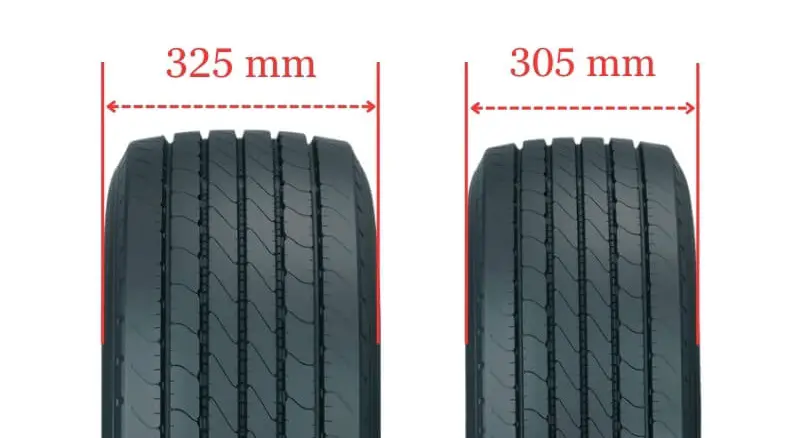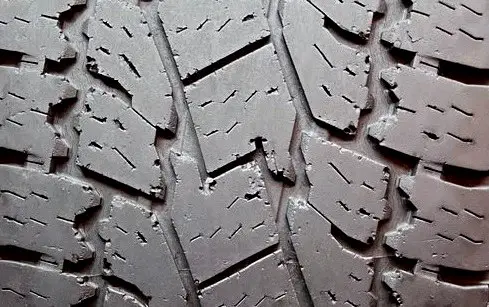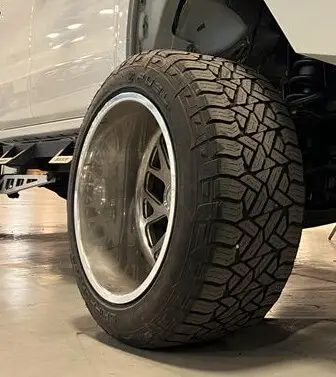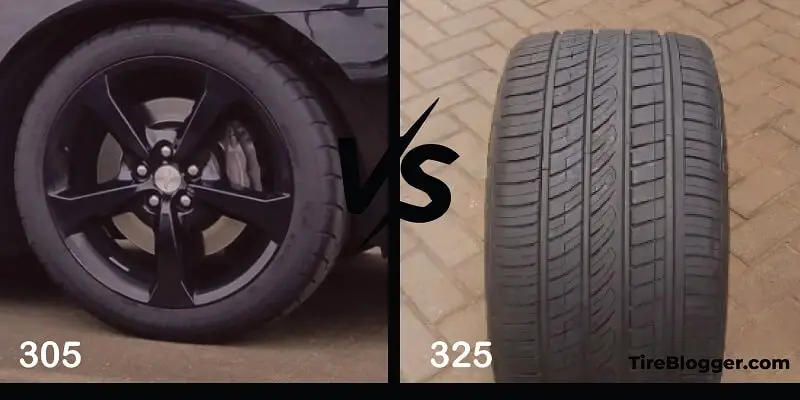305 vs 325 Tires

The main difference between a 305 and 325 tire is the tread width, with the tire size 325 being 20mm (0.79 inches) wider than the 305 tire size.
This results in a 6.6% increase in tread width for the 325 over the 305. The wider tread provides more traction and stability, especially for off-road driving.
325 vs 305 Table
We’ll compare two tires with the same aspect ratio and rim size to grasp their fundamental distinctions.
| Tire Size 305 | Tire Size 325 |
|---|---|
| Narrower Tread Width of 305mm | Wider Tread Width of 325mm |
| Slightly Better Fuel Mileage | More Aggressive Visual Appeal |
| More Responsive Handling | Enhanced Traction and Stability |
| Quieter Ride on Smooth Roads | Greater Ground Clearance |
| Potentially Longer Tread Life | Better Impact Absorption |
| Easier Cutting Through Snow/Ice | Improved Performance in Mud |
| Sleeker, More Aerodynamic Look | Handles Off-Road Conditions Better |
Ground Clearance
The 325 tire offers slightly more ground clearance due to its larger overall diameter. This can help prevent scraping and damage when driving over obstacles or rough terrain. However, the difference is minor, only a couple of millimeters at most.

Gas Mileage
The 305 tire provides marginally better gas mileage compared to the 325. The smaller contact patch and lower rotational mass lead to reduced rolling resistance.
However, the difference is again fairly small, likely only 1-2 mpg in optimal conditions. For most drivers, the mileage difference is negligible.
Ride Comfort
Both 305 and 325 tires provide a comfortable ride quality. The 325 absorbs impacts slightly better thanks to the increased sidewall height.
But the ride in a 305 is comparable on smooth highways and city streets. Overall, ride comfort depends more on tire construction than just width.
Aesthetics Look
Visually, the wider 325 tire gives a more aggressive, masculine stance. The 305 has a slightly sleeker look that optimizes aerodynamics.
However, the difference is subtle and comes down to personal preference. Both sizes can look attractive on most vehicles.

Handling & Stability
The 305 offers crispier handling and steering response on paved roads. The 325 provides a bit more stability and traction for off-road driving where loss of traction is a concern. For daily driving, both tires deliver responsive handling.
Noise & Vibration
Tire noise and vibration are similar between the two sizes, with only minor differences. The 305 transmits slightly more road irregularity vibrations, while the 325 produces marginally more noise from the tread. Overall, cabin noise is comparable.
Durability & Wear
Durability is even between the 305 and 325, assuming similar treadwear ratings. The 305 may exhibit slightly more even wear across the tread width.
Differing driving conditions significantly impact tread life more than just the width difference.
Adverse Conditions
For snow and ice, the narrower 305 can cut through to the pavement more efficiently. But the 325’s wider tread provides better traction in deep mud or loose dirt. Performance in adverse conditions has more to do with the tire tread design.

What Does 325 Mean On A Tire?
The number “325” on a tire refers to the tire’s section width in millimeters. Section width is the distance between the outermost points on the tire’s sidewall, measured when mounted on a wheel and inflated to its recommended pressure.
How Much Wider Is A 325 Tire Than A 305?
The numbers 305 and 325 refer to the tire’s width in millimeters. So a 305 tire has a width of 305 millimeters, while a 325 tire has a width of 325 millimeters.
To convert millimeters to inches, we can divide the millimeter value by 25.4. So, the difference in width between a 325 tire and a 305 tire in inches is:
(325 – 305) / 25.4 = 0.7874 inches
Therefore, a 325 tire is approximately 0.79 inches wider than a 305 tire.
How Much Taller Is A 325 Tire Than A 305?
It’s important to understand that various factors, including the aspect ratio, wheel diameter, and the specific tire model, determine the overall height of a tire.
However, if you are comparing two tires with the same aspect ratio and wheel diameter, the size of the tire will determine its height. For instance, a 325 tire is generally taller than a 305 tire.
For instance, consider 325/70R17 and 305/70R17 tire sizes. Assuming the same aspect ratio of 70 and wheel diameter of 17 inches, the overall height of the 325 tires would be approximately 34.91 inches.
In comparison, that of the 305 tires would be around 33.81 inches. Therefore, the 325 tire is approximately 1.1 inches or 28 millimeters taller than the 305 tire, assuming the same aspect ratio and wheel diameter.
Can I Replace 305 Tires With 325?
Consider replacing your 305 tires with 325 tires based on the rim width range. However, before making this change, it’s important to keep a few things in mind to ensure the new tires are compatible with your vehicle and safe to use.
Firstly, you should check your vehicle’s owner’s manual or consult a trusted mechanic to determine the maximum tire size your vehicle can safely accommodate. If your vehicle is compatible with a tire size of 325, you’ll also need to ensure enough clearance in your wheel well to accommodate the wider tire.
In addition, you should ensure that the 325 tire is compatible with your existing wheel size. As the 325 tire usually requires a wider wheel than a 305 tire, you’ll need to ensure your current wheels are wide enough to mount the 325 tires safely.
While the recommended rim width range for a 305 tire is usually between 9 to 11 inches, a 325 tire should be used with a rim width ranging from 11 to 12.5 inches. However, since both tire sizes overlap the recommended rim width range, they are potentially interchangeable.
Our Observation
Regarding comparing the 305 and 325 tire sizes, I don’t see a clear winner for all applications. The wider 325 tire looks more aggressive to me and provides more off-road traction.
But for daily driving, the 305 is just as capable and marginally more fuel efficient. Personally, I would choose based on the specific vehicle and planned usage.
I would prefer the 325 for the added traction and clearance for a pickup truck that goes off-road frequently. The 305 makes more sense to optimize handling and fuel economy on a sports coupe mainly driven on pavement.

Meet Caitlin McCormack, a Tire Size Expert and Blogger Passionate About Everything Related to Tires. With Years of Experience in the Tire Industry, Caitlin Has Become an Expert in Tire Sizes and Their Impact on Vehicle Performance.
